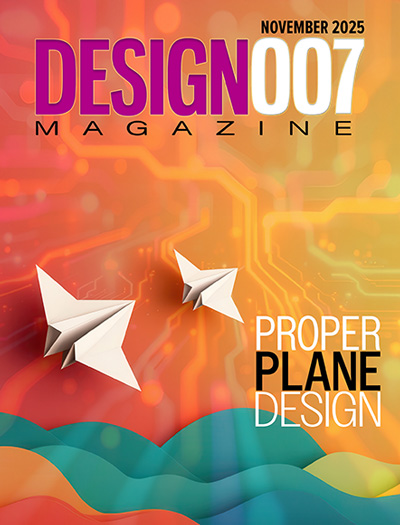-

- News
- Books
Featured Books
- design007 Magazine
Latest Issues
Current Issue
Designing Proper Work-Life Balance
In this issue, we hear from designers, marketers, and business owners on how they apply their professional skills to their personal lives to build a healthier work-life balance.

Designing Proper Planes
Without planes, designers would have to create thousands of traces to accomplish the same objectives. Power planes provide low impedance and stable power, and ground planes stabilize reference voltage, improve thermal performance, and help preclude EMI issues.

Power Integrity
Current power demands are increasing, especially with AI, 5G, and EV chips. This month, our experts share “watt’s up” with power integrity, from planning and layout through measurement and manufacturing.
- Articles
- Columns
- Links
- Media kit
||| MENU - design007 Magazine
Ventec’s Martin Cotton to Speak at Advancements in Thermal Management Conference 2017
August 2, 2017 | VentecEstimated reading time: 1 minute
Ventec International Group, a world leader in the production of polyimide and high-reliability epoxy laminates and prepregs, will present a paper on Advanced IMS Material Solutions at the Advancements in Thermal Management Conference from 9-10 August 2017 in Denver, Colorado, USA.
Martin Cotton, Ventec’s Director of OEM Technology will be presenting his technical paper entitled ‘Advanced Thermal Material Solutions’ on Wednesday, 9 August at 11am at the DoubleTree by Hilton Denver Tech Center.
Thermal issues in printed circuit boards and their related assemblies are becoming as important as the signal integrity in the design and manufacture of PCBs. The relationship between the materials used and the thermal functionality is a key focus as industry sectors tackle issues of reliability, aging and functionality. Costs and the value analysis between thermal transfer rates and materials used are fast becoming a design discipline that has huge effects on final assembly cost and thermal functionality.
Martin’s presentation introduces new generation materials, their background and what current solutions are being used by various market sectors. Discussion on the next generation of insulated metal substrates (IMS) and prepregs for printed circuit boards and hybrid constructions will be covered. Design and the value analysis required to lower cost in the final assembly while maintaining thermal function will be reviewed. Finally, the myths and misunderstandings around thermal materials and how to use them will be explained.
Martin will be joined by Jack Pattie, President of Ventec USA.
About Ventec International
With volume manufacturing facilities and HQ in Suzhou China, Ventec International specializes in advanced copper clad glass reinforced and metal backed substrates for the PCB industry. With distribution locations and manufacturing sites in both the U.S. and Europe, Ventec International is a premier supplier to the global PCB industry. For more information, click here.
Testimonial
"The I-Connect007 team is outstanding—kind, responsive, and a true marketing partner. Their design team created fresh, eye-catching ads, and their editorial support polished our content to let our brand shine. Thank you all! "
Sweeney Ng - CEE PCBSuggested Items
Elephantech Unveils HDI Microvia Formation Process Using Copper Nanoparticle Ink
12/29/2025 | ElephantechJapanese deep-tech Elephantech announced successful development of an innovative process to form High-Density Interconnect (HDI) microvia leveraging the company’s copper nanoparticle ink, named “Cu Nano Direct Plating.”
TopLine Introduces Cost-Efficient Flip Chips with Daisy Chain for Electrical Test Learning
12/23/2025 | TopLine CorporationFlip Chips with Daisy Chain from TopLine Corporation are a cost-efficient way to learn electrical test for engineers seeking to understand and practice necessary techniques for working with Flip Chip components.
Elephantech Launches Copper-on-Copper Self-Assembled Nanoparticles
12/22/2025 | ElephantechJapanese deep-tech startup Elephantech Inc. announced the successful development of Self-Assembled Copper Nanoparticles (SA-CuNP), a breakthrough technology that imparts dispersibility to copper microparticle pastes through an entirely new mechanism.
Connect the Dots: The Future of Designing for Reality—Outer Layer Imaging
12/24/2025 | Matt Stevenson -- Column: Connect the DotsIf you read my column regularly, you know I’m passionate about helping designers get the most from their designs. In my November column, I focused on designer best practices for the electroless copper component of the manufacturing process. The next step is outer layer imaging: the transition from digital to physical, and where the designer’s IP meets the board.
The Next Five Years of Thermal Substrates, Ceramics, and Thick-film PCBs
12/11/2025 | Brian Buyea, RemtecIf you want a clean view of where thermal substrates and ceramic/thick-film electronics are headed, follow the heat. Power density is moving up and to the right across industries: EV traction inverters, fast chargers, AI data centers, radar, satellite payloads, medical imaging, and high-brightness LEDs. The next five years will be defined by designs that treat thermal performance as a first-order constraint, not an afterthought. Here’s what that means in practice.


